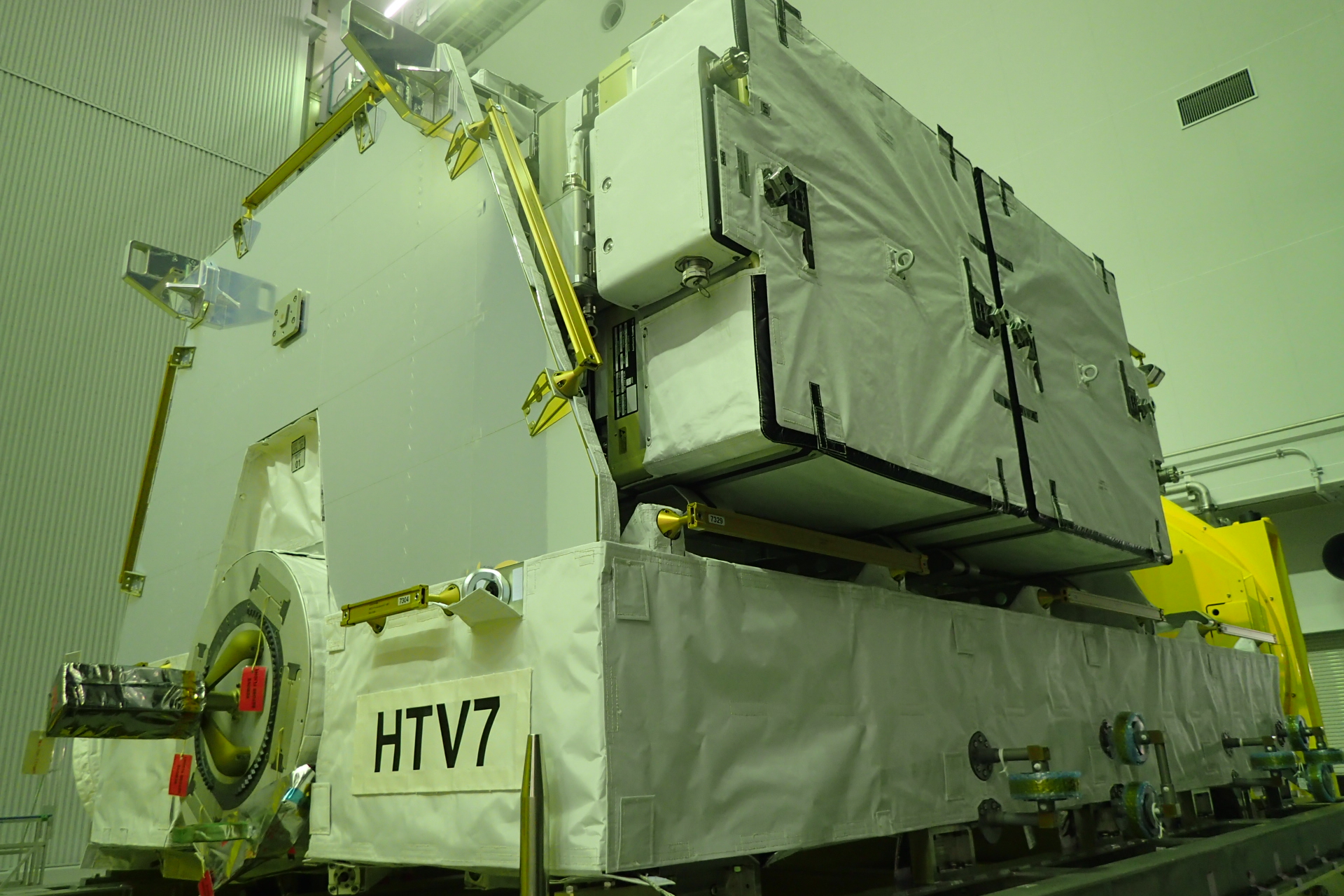Japanese Kounotori 7 brings food, science and new hardware to ISS
/Japan’s Kounotori 7 spacecraft arrived to the International Space Station to begin a two-month period attached to the outpost while crews work to unload its 6,200 kilograms of cargo.
The 9.8-meter-long spacecraft, also known as HTV-7, rendezvoused with the outpost Sept. 27, 2018. Once it was about 10 meters below the ISS, Expedition 56 Commander Drew Feustel and Flight Engineer Serena Aunon-Chancellor of NASA used the robotics workstation in the Cupola window to control the 17.6-meter robotic Canadarm2 to grab the autonomous cargo freighter. Capture occurred about 30 minutes earlier than planned at 11:34 UTC.
“We’re delighted to see HTV-7 arrive at ISS thanks to the [Japan Aerospace Exploration Agency] teams for working so hard to successfully launch this vehicle in spite of the recent challenges with hardware and weather,” Feustel said. “Thanks also to [the Canadian Space Agency] and the Canadarm2 for providing capability to grapple all of our cargo vehicles that carry critical cargo and supplies for the crew onboard and ISS. It’s always breathtaking for us to see another spacecraft orbiting alongside the space station and join up on this incredible international journey in space.”
Over the next several hours, ground teams remotely controlled Canadarm2 to maneuver the spacecraft to the Earth-facing port of the Harmony module where it was berthed at around 14:09 UTC.
Kounotori 7 launched to the ISS atop an H-2B rocket five days ago at 17:52 UTC Sept. 22 from JAXA’s Tanegashima Space Center on the island of Tanegashima in southern Japan. The liftoff came after nearly two weeks of delays ranging from weather issues to technical problems.
Inside the Pressurized Logistics Module, Kounotori 7 is carrying 4,300 kilograms. In addition to food and other crew supplies, this includes two U.S. experiment racks (EXPRESS Racks 9B and 10B), a U.S. Life Sciences Glovebox (which will be the second to be delivered to the ISS) and the European Space Agency-developed Life Support Rack.
Additionally, a device called HTV Small Re-entry Capsule, abbreviated HSRC, will also be aboard. According to JAXA, it is designed to demonstrate reentry technology and cargo recovery functions from the ISS. Currently, the only vehicles that can return any cargo from the space station are the crewed Russian Soyuz spacecraft, which offers minimal down-mass capability, and SpaceX’s cargo Dragon spacecraft, which offers a large amount of down-mass capability.
HSRC is inside Kounotori 7 and will be attached to the hatch of the Pressurized Logistics Carrier by the space station crew before the spacecraft is unberthed in November. It will separate from vehicle after a deorbit burn and re-enter the atmosphere over the Pacific Ocean near Japan, descend by parachute and be recovered after splashdown, according to JAXA.
Also inside the pressurized compartment is the Loop Heat Pipe Radiator, which is a technology demonstration system that is expected to test high-efficiency heat rejection technology. At some point after Kounotori 7 berth’s, the radiator experiment will be moved outside the space station via the Kibo module’s experiment airlock and the Japanese robotic arm will move it into position.
Finally, Kounotori 7 brought additional CubeSats to the ISS for deployment. According to JAXA, this will involve the 10th CubeSat deployment using the JEM Small Satellite Orbital Deployer since 2012.
According to JAXA, among the CubeSats being delivered are: SPATIUM-I, which will demonstrate electron density measurement, 3D mapping of the ionosphere and ultra-small atomic clock technology; RSP-00, which will demonstrate technology for imaging with an onboard camera and high-speed data transmission; and STARS-Me, which will demonstrate a small-scale space elevator using two satellites and a climber.
Inside the Unpressurized Logistic Carrier are six lithium-ion batteries to be used to replace some of the existing nickel-hydrogen batteries on the exterior of the outpost. This is a continuation of the multi-mission process that began with the Kounotori 6 flight in early 2017.
At least two spacewalks will be required to replace the old hardware with the new upgrades. These were initially scheduled to be performed by members of the six-person Expedition 56 crew. However, the various delays in the launch of Kounotori 7 necessitated these to be manifested for Expedition 57 as one of the original spacewalkers, Feustel, is slated to return to Earth Oct. 4. He will return in Soyuz MS-08 alongside two other crew members -- Ricky Arnold of NASA and Oleg Artemyev of Russia.
The spacewalks, U.S. EVA-52 and U.S. EVA-53, are now expected to be performed Oct. 19 and Oct. 25, respectively, by European Space Agency astronaut Alexander Gerst and NASA astronaut Nick Hague. Gerst, along with Aunon-Chancellor and Russia’s Sergey Prokopyev, will remain aboard ISS as members of Expedition 57 after Soyuz MS-08 undocks. Hague, along with Aleksey Ovchinin of Russia, is expected to launch to the outpost in Soyuz MS-10 from Baikonur Cosmodrome Oct. 11.







